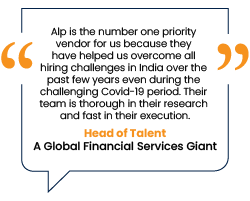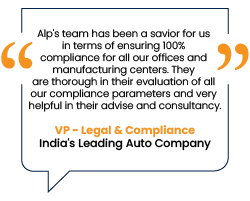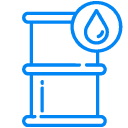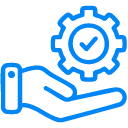Hire Smarter, Grow Faster – Expert RPO Services
In this largely competitive environment, organizations must have scalable and innovative recruitment processes to attract top-tier talent. The recruitment process outsourcing services are a great option to consider. And if you do consider, you may want to look for the best recruitment process outsourcing services in India, covering every aspect of the recruitment process. Alp Consulting is a full-lifecycle recruitment solutions company that you must consider when you evaluate RPO service providers in India.

What Is Recruitment Process Outsourcing (RPO)?

Recruitment process outsourcing is a type of business process outsourcing where the entire recruitment process or parts of it is managed by a third-party recruitment and staffing agency. Alp Consulting is a successful recruitment process outsourcing company in India that has been providing recruitment and staffing services to several Fortune 500 clients all over the world across sectors.
What are the Benefits of RPO Services?
As a reliable recruitment process outsourcing company in India, we house recruitment experts who have the experience and expertise to deliver tailored RPO services to clients as per their business needs. Some of the benefits of our Recruitment Process Outsourcing Services in India are:

Access to Top Talent
As one of the topmost companies offering recruitment process outsourcing services in India, we incorporate various recruitment methods and have gathered a quality-rich database of skilled professionals, providing clients access to top talent.

Swift Recruitment of Candidates
Outsourcing the long and tedious process of recruitment to Alp Consulting is a wise decision. We provide RPO solutions that help organizations acquire skilled candidates swiftly, reducing the time-to-fill significantly. Organizations can get access to skilled candidates swiftly in case of emergency hiring.

Cost-effective Solution
We offer RPO services in India that are scalable, cost-effective, and tailored to the client’s needs and comfort. Another significant risk of recruiting in-house is the recruitment of a bad hire. Our expert RPO services ensure high-quality hires, improving the overall efficiency of your workforce.

Better Scalability and Flexibility
Hiring needs vary from time to time in all organizations. We will offer flexible recruitment solutions to keep up with the frequency of hiring, so you can scale your workforce up or down as per your needs. Whether you need employees on a single project or to be available on-demand, we ensure that you acquire the right individuals each time to fill the roles.

Ensure Compliance with Labor Laws and Regulations
Engaging an expert recruitment process outsourcing services company in India is a great solution as they have an expert team who not only keep themselves updated on the latest developments in recruitment but also ensure 100% compliance with labor laws, avoiding fines, penalties etc.

Eliminate Burden on HR (Human Resource) Departments
Outsourcing some or all the recruitment tasks, especially those that are time-consuming, repetitive and tedious in nature, not only reduces the burden on your in-house HR team but also allows them the time to focus on other tasks like developing strategies to improve operations, directly contributing to the growth of the organization.

Boost Employer Branding
RPO providers thoroughly research a company’s brand as well as the competitors’ brands and form an analysis as to what’s lacking in the business’ brand image in comparison to others. They then form a strategy to highlight the brand’s image and improve the messaging.

Customized Recruitment Solutions
From the selection process for target candidates to the testing phase and eventual hiring, our recruitment process outsourcing services ensure delivery of the best results. We provide tailored recruitment solutions that work best for your company depending on how big it is and what stage of growth it is in.
Looking for A Trusted Talent Partner?
Acquire and manage top tier talent with our full service talent solutions tailormade for your unique industry requirements.
What are the Types of RPO Models?
1
End-to-End RPO
In this RPO model, all recruitment processes and other talent acquisition strategies will be handled by the RPO company in India. This is a long-term engagement model that can cover services like candidate attraction, candidate screening, candidate assessment, interview, onboarding, or compliance monitoring. If you have continuous hiring needs, then this model is right for your company.
2
Project RPO
This RPO recruitment model will cover all the processes involved in the end-to-end RPO model but on a short-term basis. The agreement will only be for the tenure of the project. You can also make use of this model to test or check out if engaging RPO services are suitable for the long-term goals of your company.
3
Selective RPO
In this model, you can choose to outsource only certain recruitment functions as per your company requirements. Specific functions that the internal team may not be adept at like candidate sourcing, applicant screening, candidate management, or recruitment marketing can be taken care of by a top RPO services company in India like Alp Consulting.
4
Recruiter on Demand
This flexible RPO staffing model can be used for projects with short timelines. Alp Consulting, one of the top RPO companies in India, can help you easily tackle hiring spikes or rapid changes within the organization with this model. The recruiter will customize a hiring strategy that suits your fluctuating recruitment demands.
5
Contingent Recruiter on Demand
When there is an urgency to fill some positions, you can use this model of RPO. Here, the hiring is faster, and the RPO provider needs to be paid a fee only if a candidate has been successfully hired. It is a fast-paced process, and detailed screening may not be done like in other RPO models.
Technologies We Use in Our RPO Services
We have found that some technologies can improve the efficiency of the recruitment processes, and the quality of candidates hired because of that.

How Does Recruitment Process Outsourcing Work?

Our RPO Services
As your hiring partners, we become an extension of your organization, seeking to transform your talent acquisition and recruitment process.
As your RPO partner, we offer:

Full Lifecycle Recruitment Solutions
This covers the entire recruitment process, except the hiring decision. The hiring decision would be left to the client. The recruitment partner will provide advice if needed.

Passive Candidate Hiring
Continuous access to the finest talent pool around the world through a database that is regularly updated and maintained well by a team of passionate, result-oriented recruiters.

Tailored RPO Solutions
Customized, comprehensive and scalable solutions that will work for different companies of different sizes across sectors both in India and abroad.

Full Management Support
Support for the design of screening assessments to help shortlist the best candidates and even in picking the right people for interviewing panels before the final selection.

Picking RPO Delivery Model Best Suited for You
We pick the best from the on-site, off-site or virtual delivery model for RPO, depending on the location of the business and the country it is hiring candidates from, making it easy to get the recruitment done.

Guided Assistance Through Technology
Advanced analytics, cutting-edge technology, and AI make a great combination to shortlist the best and most eligible candidates from thousands of applications, improving the efficiency of the recruitment process.
What are the Key Trends in RPO?
- The Indian RPO services market is estimated to reach $420 million by 2027, at a CAGR of 15.5%.
- This makes India a key contributor to RPO services on a global scale.
- There is a high adoption of RPO in sectors like IT, healthcare, manufacturing, and finance.
- According to NASSCOM, 60% of tech companies are exploring RPO or experiencing its benefits.
- The reason why so many companies opt for RPO remains the faster time to hire and broader talent pools.

Industries We Serve
Our Value Proposition
1
As your recruitment partner, we will assess and help improve your turnover rates, technology, scalability, analytics and performance management
2
Introduce and equip your organization’s recruitment processes with the right technology, required to power these processes
3
Extensive job marketing through various networks to ensure candidate exposure to jobs and employer’s brand
4
Build employer brand and recognition and engage future potential talent through talent pipelines
5
Ensure thorough candidate assessments and manage their job-seeking experience, whether they are being interviewed, hired or considered for the job
Trusted by 400+ Leading Brands
What Our Delighted Clients Have to Say About Us
Our clients trust us with their workforce requirements because we have proven our mettle since more than two decades.




Frequently Asked Questions
The seven stages of an RPO are as follows:
- Prepping for the ideal candidate
- Sourcing and attracting talent
- Converting applicants
- Selecting and screening candidates
- Carrying out the interview process
- Verifying the background of the candidate through a reference check
- Onboarding
Contact Us For Business Enquiry
Want to explore partnership with Alp?
Whether you are a startup on a growth trajectory or a large organization struggling to maintain your talent pipeline or a company looking to outsource HR or training functions, we have bespoke solutions for everyone!
Just submit the form above (for mobile) or on the left (for desktop) and we will get back to you within 2 working days.
Please do NOT fill the form for any job related query. If you are looking for a job please visit our careers page. If you need any support from our HR team please send an email to hr@alpconsulting.in.


































